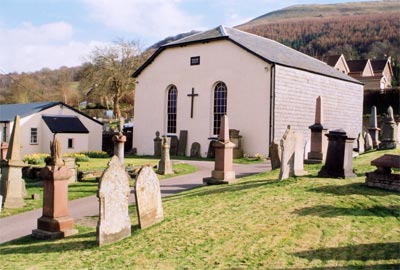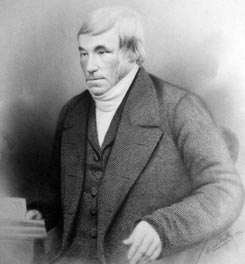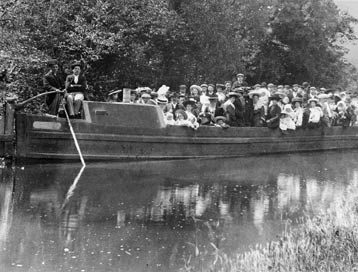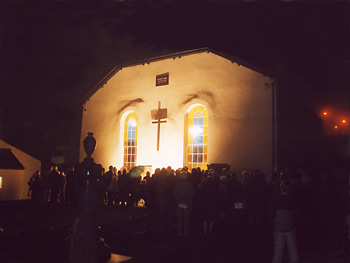|
A
Brief History of
Llanwenarth Baptist Church,
Govilon.
Like
many of the Baptist fellowships formed during
Cromwell's Commonwealth, the cause at Llanwenarth
owes its origins to a former member of the New
Model Army.
 After
leaving the Army, one John Miles came to Wales
and settled at Ilston in the Gower. After
leaving the Army, one John Miles came to Wales
and settled at Ilston in the Gower.
In 1652, supported under the provisions of the
Act for the Better Propagation of the Gospel
in Wales, John Miles travelled up the Usk Valley,
preaching and encouraging the formation of new
congregations. As a result of his ministry,
the fellowship that later became Llanwenarth
Baptist Church was formed in Abergavenny, under
the leadership of William Pritchard.
When
the Monarchy was restored in 1660, the young
fellowship was forced to go underground, as
Charles II declared all acts of worship that
did not conform to the practices of the established
Church of England to be illegal. It was not
until 1688, when Charles' brother James II was
ousted by his brother-in-law, William of Orange,
that Baptists began to feel free to worship
openly. So it was in 1695 that the fellowship,
still led by William Pritchard, leased land
from Christopher Price, a sympathetic apothecary
from nearby Llanfoist.
On this land the fellowship built their first
Meeting House, which was licensed for worship
in 1696. This small Meeting House occupied the
northern end of the current building in Govilon
- it is almost certain that part of the current
north wall dates back to that original building.
William Pritchard died in 1713, but by that
time the fellowship at Llanwenarth had already
called their next minister.
Joshua James had come to Govilon in 1695 as
co-pastor. Now he would lead the church in a
period of considerable growth. During his pastorate
Llanwenarth played a major role in the formation
of the Welsh Baptist Association (1700) and
founded a day school where children were to
'be freely instructed in reading, writing,
arithmatick, and likewise in the Principles
of Religion'.
Joshua James died in 1728 and the life of the
fellowship entered a quiet period. This lasted
until the ministry of Caleb Harris (1746-1792).
It was during his pastorate that Llanwenarth,
like many non-Conformist causes of that time,
suffered in the arguments over Unitarianism.
Caleb Harris' pastoral leadership ensured that
the fellowship remained strong, despite the
defection of one Benjamin Meredith and his followers.
As the pastorate of Caleb Harris was nearing
its end, the church again called a co-pastor.
James Lewis was called to Llanwenarth in 1791
and soon found himself in sole charge. His ministry
proved highly successful, and soon the membership
was nearly 350.
 The
church now decided to call one of her own children
to become co-pastor. Francis Hiley had only
just graduated from the Abergavenny Academy
when he was appointed by Llanwenarth in 1811.
The period of James and Francis' individual
and joint pastorates was to be the high point
of the fellowship. Between them they baptised
over 1,400 people. Francis Hiley was a renowned
preacher in both Welsh and English. Known as
the "Silver Trumpet of Gwent", he
was reported to have preached outdoors to great
crowds of over 1,000 people, standing on top
of a wall so that he could be seen by all. The
church now decided to call one of her own children
to become co-pastor. Francis Hiley had only
just graduated from the Abergavenny Academy
when he was appointed by Llanwenarth in 1811.
The period of James and Francis' individual
and joint pastorates was to be the high point
of the fellowship. Between them they baptised
over 1,400 people. Francis Hiley was a renowned
preacher in both Welsh and English. Known as
the "Silver Trumpet of Gwent", he
was reported to have preached outdoors to great
crowds of over 1,000 people, standing on top
of a wall so that he could be seen by all.
By
1830, the membership of Llanwenarth had grown
to 629. Many
members were "released" by the mother
chapel to found independent fellowships. The
largest of these was Hermon, Nantyglo. This
fellowship became an independent church in 1830,
with 238 former members of Llanwenarth being
transferred to it. Altogether,
Llanwenarth founded twelve daughter churches
throughout greater Gwent and played a major
role in the building of Baptist witness throughout
Wales.
James
died in 1837 and Francis in 1860. The times
that followed the pastorate of Francis Hiley
were times of great change. The language of
worship became English rather than Welsh, the
industrialisation of the once-pastoral community
was continuing apace, and new technology was
altering the whole way of life.  The
Merthyr, Tredegar and Abergavenny Railroad arrived;
Govilon Station opened in 1862 and horse-drawn
trams and iron-laden barges filling the canal
behind the chapel were soon just memories. New
technology caused small disturbances too. The
records contain a report of panic arising in
the congregation from the showing of 'dissolving
images' - Magic Lantern shows in the Chapel
were henceforth banned! The
Merthyr, Tredegar and Abergavenny Railroad arrived;
Govilon Station opened in 1862 and horse-drawn
trams and iron-laden barges filling the canal
behind the chapel were soon just memories. New
technology caused small disturbances too. The
records contain a report of panic arising in
the congregation from the showing of 'dissolving
images' - Magic Lantern shows in the Chapel
were henceforth banned!
Llanwenarth
nevertheless maintained its status as one of
the first Baptist churches in Wales (it is now
the oldest still in existence) and in 1866,
the Welsh Baptist Union was formed at Llanwenarth.
Throughout the 20th Century, the Chapel community
remained strong, with three Sunday School branches
(these were originally attended by adults as
well as children) - wonderful early photographs
show Sunday School outings on horsedrawn barges
around the turn of the century.
Although
the heights achieved during the times of Lewis
and Hiley have not been repeated, the fellowship
continues in good heart - as the rest of this
web-site shows - and celebrated its 350th Anniversary
in 2002. 
The
celebrations began with the illumination of
a new wooden cross on the ancient North Wall
of the building, on January 5th 2002.
If
you want to know more about the history of this
fellowship please contact the Minister. There
are records dating back to the foundation of
the cause in 1652, and a book detailing the
history of the chapel was published for the
350th Anniversary.
(However, please note that
like most early Baptist churches, no records
were kept of Births, Marriages and Deaths. Early
Baptist church records mainly consist of details
of church meetings, appointments of deacons
and financial matters.)
|